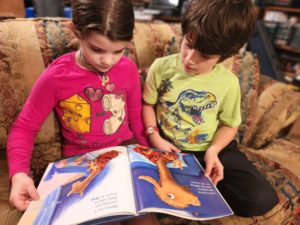 One of the greatest achievements of my life is passing on the gift of knowing how to read. Reading opens the door to learning every other subject. It can take one to faraway lands or offer a peek into another person’s heart. Your world will grow larger with each book you read.
One of the greatest achievements of my life is passing on the gift of knowing how to read. Reading opens the door to learning every other subject. It can take one to faraway lands or offer a peek into another person’s heart. Your world will grow larger with each book you read.
I have had the distinct pleasure of teaching ten (soon to be eleven) people to read over my lifetime thus far. This thrill was first experienced when I was only thirteen years old. My seventh-grade English teacher found herself with an accelerated student mistakenly placed in her class rather than the advanced one and a student whose family had recently immigrated here from Nigeria. My classmate Tayo could not read a word of English while I had taken my literature book home and read it from cover to cover during the first week of school.
Our clever teacher paired us up. From that point on, when I arrived at my 6th-period class each day, Tayo and I pushed our chairs together at the back of the room. Head-to-head, we worked through the alphabet and the sound each letter makes, consonant blends and digraphs (although I had no idea that’s what they were called at that time), long and short vowels, and the crazy intricacies of the English language. By the end of the school year, Tayo could read enough to make it through her classes without an aide, while I was given the incredible gift of being a part of the process with her.
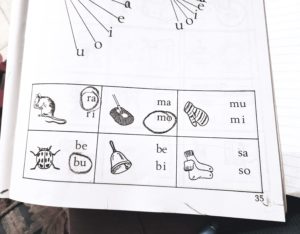 Years later, when I began homeschooling my first son, I again felt the joy in seeing that moment when it all “clicked” in his mind as he began putting sounds together to make a word. In fact, this is one of my favorite things about homeschooling; I would not easily give up this privilege to a classroom teacher. I have now worked through the process of learning to read with nine of my children and am presently teaching my youngest one. I am frequently asked, “How do you teach a child to read?” or “What reading program do you use?” Let me share with you what has worked for me.
Years later, when I began homeschooling my first son, I again felt the joy in seeing that moment when it all “clicked” in his mind as he began putting sounds together to make a word. In fact, this is one of my favorite things about homeschooling; I would not easily give up this privilege to a classroom teacher. I have now worked through the process of learning to read with nine of my children and am presently teaching my youngest one. I am frequently asked, “How do you teach a child to read?” or “What reading program do you use?” Let me share with you what has worked for me.
We start with a handwriting book. We use the Italic Handwriting series by Getty-Dubay, but any handwriting system would suffice. I also keep some of those Dollar Store blank handwriting tablets on hand for additional practice. As my child learns how to write a new letter, I also teach him the sound it makes. Most handwriting books will have a drawing to go with the letter, such as an elephant for “E” or an igloo for “I.” As the child moves through the book, I quiz him each day on the previous letters he has learned, covering up the drawing unless he needs a clue to help him recall it.
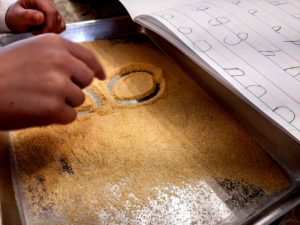 Along with the handwriting books, I pour a thin layer of cornmeal on a cookie sheet and let my child draw the letters in the cornmeal while saying the sound it makes. This extra layer of sensory input helps the child’s brain form a stronger synaptic connection. After we have gotten through 8-10 letters, I draw a letter and have him guess or the reverse: I make the sound for him to draw the corresponding letter.
Along with the handwriting books, I pour a thin layer of cornmeal on a cookie sheet and let my child draw the letters in the cornmeal while saying the sound it makes. This extra layer of sensory input helps the child’s brain form a stronger synaptic connection. After we have gotten through 8-10 letters, I draw a letter and have him guess or the reverse: I make the sound for him to draw the corresponding letter.
We also have enjoyed using the workbooks from Pathway Publishing called Learning Through Sounds and Time to Read. They have simple line drawings that further reinforce each letter’s phonetic sound. An Amish publisher prints these, so we occasionally encounter a drawing that I have to explain, such as a buggy, bonnet, or water pump. These have provided an interesting peep into another culture that my children have found intriguing.
As each child progresses through the alphabet, they discover letters in the world around them. They have all reached a point where they realize that there are letters everywhere – and how exciting for them to recognize them! As we move to the next step, their excitement grows even more. Three-letter words with short vowel sounds show how putting the letters together creates a word. The workbook pages they have been doing have already introduced them to the concept of rhyming and taught them to listen for the beginning and vowel sounds in words. Now they apply those basic skills to words like C-A-T, B-A-T, F-A-T and F-O-G, D-O-G, L-O-G. Next, I will switch vowel sounds in the middle of words, as in P-I-T, P-A-T, P-O-T, and P-E-T. It is typically at this point that they experience the “light bulb over the head” moment, and their eyes light up with understanding.
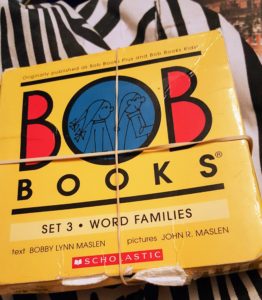 The next step in teaching my children to read is adding an “E” at the end of words to create a long vowel sound. C-A-P becomes C-A-P-E, K-I-T becomes K-I-T-E, and H-O-P becomes H-O-P-E. At this stage, we may employ some beginner readers, such as the Bob Books series. We have also used a set from Abeka. These will have short stories that the child can read with only these simple introductory words. You can often borrow the Bob Books from the public library.
The next step in teaching my children to read is adding an “E” at the end of words to create a long vowel sound. C-A-P becomes C-A-P-E, K-I-T becomes K-I-T-E, and H-O-P becomes H-O-P-E. At this stage, we may employ some beginner readers, such as the Bob Books series. We have also used a set from Abeka. These will have short stories that the child can read with only these simple introductory words. You can often borrow the Bob Books from the public library.
Once my child has reached this stage, they begin the first in a series of readers. The ones that our family has used for over twenty years are the Pathway Readers, published by the same company that makes the workbooks previously mentioned. Each reader has an accompanying workbook. In the first few lessons of the first reader, the parent reads the first paragraphs of the story of the day, and then the child reads a paragraph or two. The focus of the workbook pages is on reading comprehension, continuing phonics practice, beginning grammar rules, and spelling. Gradually, the portion of the reading done by the parent is phased out as the child’s capacity increases. (By the way, these readers go up through the eighth grade if you continue with the series. For our school, we add a vocabulary workbook by the same publisher beginning with the 3rd or 4th grade.)
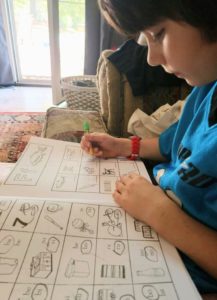 You may be wondering at what age we begin this process of learning to read. As my child approaches age five, I begin to watch for signs of reading readiness. Pretending to read their story books, copying letters that they see in a book or on one of our school room (a.k.a. dining room) posters, and asking to be taught are good indicators. These activities show that their brains are reaching a stage of development that is prepared for grasping phonics concepts without it being stressful to them. Unfortunately, I have seen many children become turned off from reading because it was pushed on them too early or too fast.
You may be wondering at what age we begin this process of learning to read. As my child approaches age five, I begin to watch for signs of reading readiness. Pretending to read their story books, copying letters that they see in a book or on one of our school room (a.k.a. dining room) posters, and asking to be taught are good indicators. These activities show that their brains are reaching a stage of development that is prepared for grasping phonics concepts without it being stressful to them. Unfortunately, I have seen many children become turned off from reading because it was pushed on them too early or too fast.
A couple of my children began reading at the age of five. For others, it was a couple of years later. If they showed signs of stress or distaste at any stage of this process, I backed off for a short time, then eased into it again a few months later. As a result, every one of my children has gone from the point of truly grasping the formation of short vowel words to reading entire story books in a matter of months. Most were seven years old when we really got into their reading lessons but by the end of their first school year, all were reading on a second-grade level. I am convinced that the most vital key to this was waiting until each child was ready.
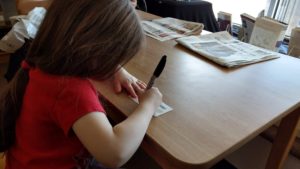 All of my children share their mother’s love of reading. I have read to them from infancy and continue to read to them regularly, even as they grow into their teenage years. We listen to books on tape when we are driving, particularly on long trips. Some of our family favorites are the Little House on the Prairie series, The Basket of Flowers, and All-of-a-Kind Family. We have bookshelves in nearly every room of our house that are filled with hundreds of books. We are on a first-name basis with the librarians at our local branch. Getting their first library card on their fifth birthday is a family tradition. Reading is a passion that I have been thrilled to share with others.
All of my children share their mother’s love of reading. I have read to them from infancy and continue to read to them regularly, even as they grow into their teenage years. We listen to books on tape when we are driving, particularly on long trips. Some of our family favorites are the Little House on the Prairie series, The Basket of Flowers, and All-of-a-Kind Family. We have bookshelves in nearly every room of our house that are filled with hundreds of books. We are on a first-name basis with the librarians at our local branch. Getting their first library card on their fifth birthday is a family tradition. Reading is a passion that I have been thrilled to share with others.
If you have questions about teaching your child to read or need advice on other areas of homeschooling, NCHE offers one-on-one mentoring sessions. One of the benefits of membership is a complimentary 30-minute session with one of our trained mentors. Additional sessions can be purchased. Check out our mentor page for more information.
 Jessica Frierson is a homeschool graduate and has been homeschooling her ten children since 2000. She serves as the secretary for NCHE, writes for GREENHOUSE, and is the lead blogger for the NCHE blog.
Jessica Frierson is a homeschool graduate and has been homeschooling her ten children since 2000. She serves as the secretary for NCHE, writes for GREENHOUSE, and is the lead blogger for the NCHE blog.
All photos by Jessica Frierson
The post Teaching a Child to Read appeared first on North Carolinians for Home Education.
